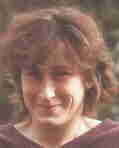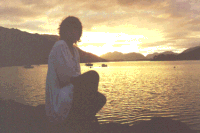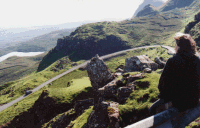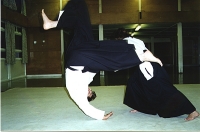A Personal Interpretation
 I remember with affection the first
Aikido session I watched. As an observer, I wondered at the fluidity of movement,
the delicacy and stability of the rolls and the continual hive activity on
the tatami. But what I remember most of all was the scent of peace, which
delicately lingered over the dojo. I paused to wonder why, stepped on the
mat and promptly lost touch with the feelings which initially drew me there
in the first place. I felt slow, awkward, hesitant, restricted and afraid.
Four years on, the memory of those initial positive feelings is still strong.
In retrospect, as a newcomer, I saw the reflection on the water. Having dipped
my toe in, the ripples disturbed the view. As I stepped in further, the ripples
became waves, but as I got used to the water and the depth, eventually the
reflection began to re-emerge and the water felt warmer. More interesting
though, something lay beneath the surface.
I remember with affection the first
Aikido session I watched. As an observer, I wondered at the fluidity of movement,
the delicacy and stability of the rolls and the continual hive activity on
the tatami. But what I remember most of all was the scent of peace, which
delicately lingered over the dojo. I paused to wonder why, stepped on the
mat and promptly lost touch with the feelings which initially drew me there
in the first place. I felt slow, awkward, hesitant, restricted and afraid.
Four years on, the memory of those initial positive feelings is still strong.
In retrospect, as a newcomer, I saw the reflection on the water. Having dipped
my toe in, the ripples disturbed the view. As I stepped in further, the ripples
became waves, but as I got used to the water and the depth, eventually the
reflection began to re-emerge and the water felt warmer. More interesting
though, something lay beneath the surface.
 Striving / searching to find the truth
or to develop a deeper understanding of the world around us is a human quality
which philosophy can nurture and encourage or stifle and repress by unwittingly
blinking or controlling a persons search. Some philosophies (or some people's
interpretation of them) can also try to provide an 'immediate answer', which
feels good, but fails to develop within ourselves. Aikido is one method of
searching. There are many. The direction of the search can be guided by the
immediate surroundings and philosophy/teaching methods of the dojo (in this
case Seishin Ryu) and also through Kyushindo Philosophy as developed by Abbe
Sensei and promoted by the Tokushima Budo Council.
Striving / searching to find the truth
or to develop a deeper understanding of the world around us is a human quality
which philosophy can nurture and encourage or stifle and repress by unwittingly
blinking or controlling a persons search. Some philosophies (or some people's
interpretation of them) can also try to provide an 'immediate answer', which
feels good, but fails to develop within ourselves. Aikido is one method of
searching. There are many. The direction of the search can be guided by the
immediate surroundings and philosophy/teaching methods of the dojo (in this
case Seishin Ryu) and also through Kyushindo Philosophy as developed by Abbe
Sensei and promoted by the Tokushima Budo Council.
Kyushindo as I understand it actively promotes and develops searching for the truth by highlighting principles which can unite us with the world and Universe around us. Kyushindo is based or three main principles, i.e.
* All things in the Universe are in a constant state of motion
* Motion is rhythmic and flowing
* All things work in perfect harmony and accord
 These principles which incorporate
Universal laws of nature are not isolated to Aikido/Budo/Martial arts, but
they are like the Universe itself, i.e. constantly developing. Aikido represents
an expression of part of the Kyushindo Philosophy and the Universal laws provide
a structure with which we can try to make sense of the perceived chaos we
see before us. A newcomer may step on the tatami and experience their own
form of chaos. "Where does this foot go?" "What do I do now?"
"What is expected of me?" The persistence perceived instability
can feel challenging to some and daunting to others. Some search for stability
and structure by learning techniques text book fashion, others rush, others
just feel lost at sea, but whatever the method we search in our own ways for
the structure, rules and principles. An understanding of these can help us
to further understand our source (i.e. the beginning) and ultimately predict
in some sense what is to come (our future). We can also start to understand
what is it that links the past and the future in the Universe, i.e. the driving
force that propels us on and which links all and everything.
These principles which incorporate
Universal laws of nature are not isolated to Aikido/Budo/Martial arts, but
they are like the Universe itself, i.e. constantly developing. Aikido represents
an expression of part of the Kyushindo Philosophy and the Universal laws provide
a structure with which we can try to make sense of the perceived chaos we
see before us. A newcomer may step on the tatami and experience their own
form of chaos. "Where does this foot go?" "What do I do now?"
"What is expected of me?" The persistence perceived instability
can feel challenging to some and daunting to others. Some search for stability
and structure by learning techniques text book fashion, others rush, others
just feel lost at sea, but whatever the method we search in our own ways for
the structure, rules and principles. An understanding of these can help us
to further understand our source (i.e. the beginning) and ultimately predict
in some sense what is to come (our future). We can also start to understand
what is it that links the past and the future in the Universe, i.e. the driving
force that propels us on and which links all and everything.
In order for the Universe to be in a constant state of motion, be flowing and be in harmony, Kyushindo states that the Universe must have parts, which are related to each other, and not parts that are working totally in isolation. Natural forces e.g. gravity work to unify the parts.
A simple katatedori 'attack' illustrates the above points. The initial triangular stance (sankakutai) is low and provides a central stability from which nage can create further movement. The lowered hara (tanden dosa) enhances the laws of gravity and motion (the closer an object to the earth, the stronger the unifying force of gravity - Einstein). In close unity with the earth, a lowered center and open non-aggressive hand draws uke's attack into the area of stability. Nage accepts and empathizes rather than fighting the perceived 'attack'. In drawing the negative energy towards the center and stability, a natural curvature is formed. This is the result of objects/people and gravitational forces working together. In order to be 'real', the 'attack' must be committed and move,i.e. being a state of constant motion. Nage's and uke's response (not reaction) must be flowing, have life/breath/spirit/ki and be in perfect harmony and accord in order to prevent a collision and potential wastage of energy. A harmonious flowing response creates further 'attraction' between uke and nage like that of a giant planet being drawn around the sun. Ki , the eternal life force flows freely and unites.
In Irimi nage, the energy which constitutes uke's attack, is gathered up my nage on entering. At the peak of it's natural curvature the energy is stabilized and swung back to uke in the shape of a large arc like the passage of a comet across the sky. Nage steps in further towards uke in order to create a new center of gravity (which now incorporates both uke's and nage's center of gravity) and thereby creates a new source of unification. In accordance with Universal laws, irimi nage further demonstrates and symbolizes the principles of expansion and contraction, rising, falling and recoil. In absorbing uke's 'attack' nage contracts and sinks in stance. In stepping in and returning the initial attack, nage expands and rises. This rhythmic flowing movement creates life and breath to the technique and demonstrates that constant movement occurs on many planes and parallels.
These same principles are evident throughout many Aikido techniques and movements whether the object being related too is a uke/person, a jo, a bokken or the tatami. Nage's extension of energy and uke's breakfall jointly serve to harmonize the link between uke's body and the earth.
When I first stepped on the tatami, I unwittingly disturbed the laws of nature. Hesitancy, a lack of knowledge of what to do and my own fears prevented fluidity of movement and constancy of movement. I worked in isolation and found it difficult to interact with the movements and techniques around me. Rigidity reduced my ability to freely respond to nage's guiding hand. I found it hard to experience the voids and keep an open mind to the responses needed. As the dust settled and the 'chaos' became slightly less chaotic I slowly began to sense a degree of stability and structure. The frozen water began to melt.
 During
training sessions we practice the movements which symbolizes the above principles
and when it goes well, there is a sense of well being and harmony. We may
even practice the above in a multiple attack situation. But how does this
link with striving with the truth? A perceived verbal attack in any situation
or a piece of bad luck may of course be dealt with in the same way i.e. absorbed,
dissolve and handed back safety, but why does it seem harder in real life
when the attack may hurt your feelings, or may undermine (wittingly or unwittingly).
For me, the multiple attack practice particularly begins to make a line between
practicing techniques on the mat and looking at how the values can be applied
to everyday life as the stresses of everyday life tend to happen unison. For
example, on a very simple level, the traffic might be bard going to work ('attack'
1), the milk for the coffee has gone off ('attack' 2), the boss is grumpy
('attack' 3), the computer goes down (4), you leave work late (5) and you
feel shattered when you get home(6). As in the multiple on the mat, the aim
is still to maintain a sense of stability and harmony. The aim is also still
to centralize and defuse the energy the energy around before it escalates
and swings out of control, but the actual practice of this can be hard and
a lifetime to master. Unfortunately, it is not possible to live in isolation
and 'attacks' in whatever form are a part of the complexity of life. The search
for the truth must therefore look within the one thing that unites all the
above, i.e. the self.
During
training sessions we practice the movements which symbolizes the above principles
and when it goes well, there is a sense of well being and harmony. We may
even practice the above in a multiple attack situation. But how does this
link with striving with the truth? A perceived verbal attack in any situation
or a piece of bad luck may of course be dealt with in the same way i.e. absorbed,
dissolve and handed back safety, but why does it seem harder in real life
when the attack may hurt your feelings, or may undermine (wittingly or unwittingly).
For me, the multiple attack practice particularly begins to make a line between
practicing techniques on the mat and looking at how the values can be applied
to everyday life as the stresses of everyday life tend to happen unison. For
example, on a very simple level, the traffic might be bard going to work ('attack'
1), the milk for the coffee has gone off ('attack' 2), the boss is grumpy
('attack' 3), the computer goes down (4), you leave work late (5) and you
feel shattered when you get home(6). As in the multiple on the mat, the aim
is still to maintain a sense of stability and harmony. The aim is also still
to centralize and defuse the energy the energy around before it escalates
and swings out of control, but the actual practice of this can be hard and
a lifetime to master. Unfortunately, it is not possible to live in isolation
and 'attacks' in whatever form are a part of the complexity of life. The search
for the truth must therefore look within the one thing that unites all the
above, i.e. the self.
Discovery of the self and our place in the universe around us whether it be through Kyushindo, religion, the method of teaching/philosophy in the dojo or through our own personal methods is the ultimate challenge. Finding that the enemy lies within rather than outside can be a frightening, painful and a lonely experience. It can also be revelation. Realizing that the 'attacks' within, tend to be of the multiple variety can be even more devastating or, alternately, even more of a revelation. Memories , fears, expectations, dreams, anger, hurt, can symbolically impinge upon our internal stance and destabilize our true central point. Our timing, distance and relationship with 'ourselves' (and therefore others) becomes shaky and confused. The ability to draw in the 'attack' is compromised and the ability to redirect in a safe and non-aggressive manner can be lost. A sense of chaos, fear, loss of personal control may take over. Our ability to love both ourselves and others is lessened. Our fears and anger make us vulnerable to further attack and close the mind, which only serves to stop us from responding positively and harmoniously with the world around and within us.
Our response to uke and nage both on and off the mat, reflects back to us like a mirror, our strengths and weaknesses, our hopes and fears. Aikido could be said to provide a structured method of discovery within the safe environment of the dojo where is always someone to talk to or something to try out when things feel good or bad. And at the end of the day, when the chaos seems particularly chaotic, we can always go back to practicing ikkyo with a simple ai hanmi katatedori attack in order to remind us of the principles we are trying to apply to the chaos.
Aikido can be a life times voyage of discovery if that is what the individual is looking for. It can also be a good way of getting some exercise if that is what you are looking for. It's also is handy if you like going down to the pub! But by the time first dan is reached, no matter what the motive is behind taking the grade and continuing training, the sail will be rigged, but it seems you will still have to work out which way the wind is blowing before finally setting off.